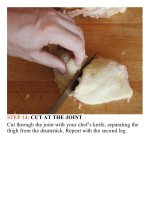The food lab better home cooking through science ( PDFDrive ) 464
Bạn đang xem bản rút gọn của tài liệu. Xem và tải ngay bản đầy đủ của tài liệu tại đây (132.12 KB, 2 trang )
difficult to cook—their thinner fillets are prone to
overcooking.
• Arctic char are . . . not salmon. But they
haveasimilarreddish-orangeflesh,coloredbythe
carotenoid pigments they get from feasting on
small shellfish. Their flavor and cooking qualities
are quite similar to sockeye salmon, though they
tendtobealittlefattier.
Ingeneral,Ipreferlarger,fattierkingsalmonfor
high-heat cooking methods like pan-roasting, and I
find that more flavorful coho and sockeye take well
to slower cooking methods, like poaching. The
thicknessandhigherfatcontentofkingsalmonfillets
offer a little more protection from overcooking or
dryingout,boththingsthatsalmonispronetodoin
thehighheatofapanoranoven.
ULTRA-CRISPSKINNEDPANROASTEDFISH
FILLETS
NOTE: This recipe will work with any skin-on firmfleshed fish fillets, such as salmon, snapper, grouper, or
bass. I prefer salmon rare to medium-rare; white-fleshed
fishshouldbecookedatleasttomedium.
SERVES4
4skin-onfishfillets(about6ounceseach)
Koshersaltandfreshlygroundblackpepper
2tablespoonsvegetableorcanolaoil
1.Pressthefilletsbetweenpapertowelstodryallsurfaces
thoroughly. Season on both sides with salt and pepper.
Heat the oil in a large heavy-bottomed stainless steel
skilletovermedium-highheatuntilshimmering.Andthe
fishfilletsskinsidedown,immediatelyreducetheheatto
medium-low, and cook, pressing gently on the back of
thefilletswithaflexiblemetalfishspatulatoensuregood
contact between skin and pan for the first minute.Then
continuecookinguntiltheskinhasrendereditsfatandis









